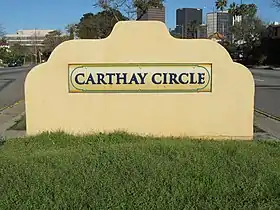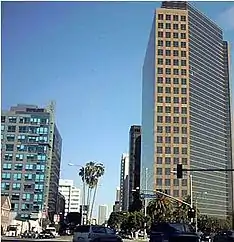Carthay Circle, Los Angeles
Carthay Circle is a neighborhood in the Mid-City West region of Central Los Angeles, California. Originally named Carthay Center, the neighborhood was later re-named after the famed Carthay Circle Theatre. [1]
Carthay Circle | |
|---|---|
 Carthay Circle signage located on San Vicente Boulevard | |
 Carthay Circle Location within Los Angeles | |
| Coordinates: 34°03′41″N 118°22′11″W | |
| Country | |
| State | |
| County | |
| Time zone | Pacific |
| Zip Code | 90048 |
| Area code(s) | 323 |
Geography
The neighborhood is bounded by Wilshire Boulevard to the north, Olympic Boulevard to the south, and Fairfax Avenue to the east.[2] The neighborhood of South Carthay is located south of Olympic Boulevard.
History
Originally named Carthay Center, Carthay Circle was developed as an upscale residential district in 1922 by J. Harvey McCarthy, who founded the 136-acre, mainly Spanish Revival, community. No two homes are alike due to the rule that all homes had to be designed individually by an architect, and notable designers such as Irving Gill, Paul Williams and Robert Byrd contributed to the neighborhood. [3]
The master plan for Carthay Circle was designed by leading early 20th century architects Aleck Curlett and his partner Claud Beelman (designer of MGM Studios and Downtown LA's Eastern Columbia Building) in conjunction with landscape architects Cook & Hall (Wilbur D. Cook is also noted for creating the master plan for the neighboring city of Beverly Hills).
McCarthy named the streets in honor of prominent figures of the California Gold Rush.[4] He also planned the neighborhood around a shopping center.[2]
Carthay Circle was one of the first planned communities in Los Angeles,[5] and the first in the city to feature underground utilities. The success of Carthay Circle served as the catalyst for the growth of the entire Mid-City area.
The main feature of the neighborhood was the Carthay Circle Theatre, the “Showplace of the Golden West," that opened May 18, 1926 and soon became the focal point of Carthay Center.[1] The theater, site of film premieres including Disney's Snow White and the Seven Dwarfs (their first full-length animated film) and the West Coast premiere of Gone with the Wind, inspired the community to change the name from “Carthay Center” to “Carthay Circle.” [6] The theater was demolished in 1969 [7] to make way for a new office complex, 1 Carthay Plaza, today known as Carthay Campus, designed in the mid-century Brutalist architectural style. A large-scale replica of Carthay Circle Theater opened in 2012 at Disney California Adventure Park in Anaheim, California.
Parks and Recreation

in Carthay Circle Park.
- Carthay Circle Park - The park is located at the intersection of McCarthy Vista & Crescent Heights Boulevard and is maintained by the City of Los Angeles.[8]
Landmarks
"The Pioneer” is a statue by Henry Lion that was designed as part of a fountain in Carthay Circle Park. [9] Standing about seven feet tall and weighing 512 pounds, it was installed on September 25, 1924.[1] Also known as "Dan the Miner", the statue went missing in 2009. It has been stolen during a rash of robberies spawned by rising copper prices. The statue was recovered, repaired, and reinstalled in 2010.[9]
Historic Preservation Overlay Zone
The Carthay Circle Historic Preservation Overlay Zone (HPOZ) adopting ordinance became effective on July 24, 1998. [10] The Carthay Circle preservation plan was adopted by the City of Los Angeles on December 9, 2010.
The following architectural styles are present in the Carthay Circle HPOZ:[11] Colonial Revival, Dutch Colonial Revival, English Tudor Revival, French Eclectic, Monterey Revival, Spanish Colonial Revival and Minimal Traditional. Objectives of the HPOZ include: Safeguarding the character of historic buildings and sites and recognizing and protecting the historic streetscape and development patterns.[12]
References
- Meares, Hadley. "Pioneers, Politics, and Punches: Dan the Miner, Carthay Circle, and Dirty Dealings in the Golden West".
- Winkler, Robert. An Arch Guidebook to Los Angeles. p. 163.
- "Carthay Circle Neighborhood Association - History of Carthay Circle". www.carthaycircle.org.
- "Carthay Circle - Office of Historic Resources, City of Los Angeles". preservation.lacity.org.
- "History of Miracle Mile/Carthay Circle | Los Angeles Conservancy". www.laconservancy.org. Retrieved 2019-09-13.
- "Carthay Circle - Office of Historic Resources, City of Los Angeles". preservation.lacity.org.
- "Carthay Circle Theatre in Los Angeles, CA - Cinema Treasures". cinematreasures.org.
- "CARTHAY CIRCLE PARK - City of Los Angeles Department of Recreation and Parks". www.laparks.org.
- Young, Jacy. "LAistory: Dan the Miner". Archived from the original on 2017-10-30. Retrieved 2017-10-02.
- "Carthay Circle Ordinance" (PDF).
- "Carthay Circle HPOZ" (PDF). Retrieved 29 April 2020.
- "Los Angeles City Office of Historic Resources" (PDF).
